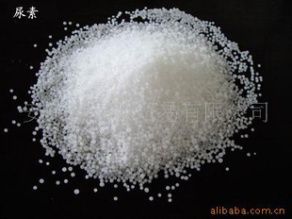|
Urea is a
white crystalline substance with the chemical formula
CO(NH2)2; it is highly water soluble and contains *6%
nitrogen. Urea is considered an organic compound because
it contains carbon. It was the first organic compound
ever synthesized by chemists; this was accomplished in
the early ***0s.
|
|
|
Answers
|
|
How is urea made?
|
Urea is made by reacting carbon dioxide (CO2) with
anhydrous ammonia (NH3) under 3,**0 psi pressure and at
**0° F.
CO2
2NH3 > CO(NH2)2 H2O
The removal of water that occurs during the reaction is
referred to as "dehydration." The resulting molten
mixture is further processed into either prills or
granules.
|
|
What is the difference between granular urea and Prilled
urea in term of physical appearance and application?
|
Granular urea is somewhat larger in size than are prills,
but the color will be the same as is the application
technique.
Is it related to how the spreader machines/ applicators use
bigger granulation, and hand/manually spread use prill
/smaller granulation?
|
|
Is urea use increasing?
|
Urea use is up substantially. In the western U.S., for
example, urea use has increased from *8,**0 tons in ***5 to
**0,**0 in ***9, a **-fold increase. Urea is the fastest
growing dry nitrogen fertilizer used by farmers.
|
|
What role does urea play in world commerce?
|
Urea is the major fertilizer traded in international
commerce. In the very near future urea is expected to
account for more than *0% of the nitrogen fertilizer in
world trade. When compared to other dry fertilizers, urea
has captured more than *5% of the world
trade.
|
|
Why is there such a shift to urea in world trade?
|
Urea has a number of advantages over other nitrogen
fertilizers. Urea is safer to ship and handle, it is less
corrosive to equipment, it has a higher analysis than any
other dry nitrogen fertilizer and it can be used on
virtually all crops. Urea can be stored and distributed
through conventional systems. It can be applied in many
different ways from sophisticated aerial application
equipment to a farm spreading urea by hand. Urea is also
highly water soluble so it moves readily into the soil. The
high analysis means a reduced transportation and
application cost per pound of nitrogen.
|
|
How much nitrogen does urea contain?
|
Urea is *6% nitrogen. This is the highest concentration dry
nitrogen fertilizer available.
|
|
How much nitrogen does urea supply?
|
Urea supplies more nitrogen per ton of product than any
other dry fertilizer. It contains *6% nitrogen; this means
that each ton of urea supplies **0 lbs. of nitrogen. For
comparison, a ton of ammonium sulfate supplies only **0
lbs. of nitrogen and a ton of ammonium nitrate supplies
only **0 lbs. of nitrogen. The higher nitrogen content
means lower transportation and application costs per pound
of nitrogen.
|
Does urea "tie-up"
in the soil?
|
Urea itself is very mobile because it is a neutral
molecule, it has no charge and is not attracted to soil
particles. This means it can rapidly move into the soil
following irrigation or rain. Once in the soil, however, it
is rapidly converted into ammonic nitrogen, which is
attracted to the soil particles, thus preventing leaching
loss.
|
|
|
|
|
What is the best nitrogen fertilizer for aerial
applications?
|
Urea is the best source of nitrogen for aerial application.
Because urea has the highest analysis (*6% nitrogen), it
has the lowest application cost per pound of nitrogen. The
uniform area granules mean that applications can be
accurately calibrated and evenly spread. Urea can be
practically dust-free and, under most conditions, it does
not absorb moisture and cake up.
|

